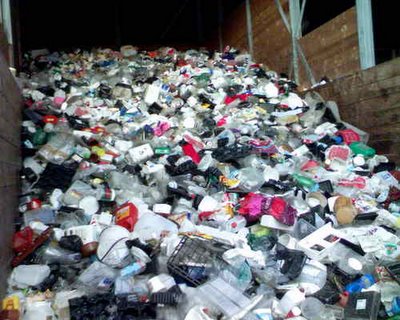The site was established in ’76 after the previous landfill was capped, and it was expected to fill up in 25 years. Instead they started sorting, recycling and composting on maybe 75% of the area, and only use the remaining 25% or so for land fill. Due to their efforts this far smaller area for landfill is now expected to last 80-90 years – a pretty solid improvement in terms of violating the 3rd Sustainability Principle.
The facility supports the population of about 62,000 people – so it’s not huge, but pretty significant. The amount of material going to landfill has fallen off by about 50% since the ‘90s, due in large part to some modest regulations and financial incentives, as well as outreach and education in the community to help people figure out how to sort waste – particularly organic waste that now gets composted. The company (which is actually owned by the municipality, but runs like a business) also recaptures methane from the landfill and uses it to heat their facilities as well as piping some to the district heating plant.
They had a bunch of roofed concrete bays for the various materials. Plastics are mostly sorted by households and businesses – soft plastics get bailed at this site and sent to incinerators, and hard plastics get sent to a recycling facility.
In the middle of the site were large piles of garden waste – branches and shrubs – that were waiting to be chipped. Just beyond these piles were a few long structures, side by side that looked like barracks. They had retractable roofs, so they could be filled with compost materials – kitchen scraps that households have separate bins for, plus the chipped garden waste. When one was full the roof was closed, and the material sat to compost for four weeks. There is a pump system built into the floor of these units that periodically (every couple of minutes or so) blows air into the pile to keep the mix oxygenated. Next the mix sits in an outside been for a couple more weeks, and after 6-8 weeks, they’ve got nutrient rich fertilizer that they can sell to offset some of the costs.
Maybe it’s something cultural about the Swedes that they have the patience and follow the rules enough to set up such a system and make it work – but once it’s up and running smoothly, the results are staggering, if not surprising. As we move towards sustainability ‘closing the loops’ in the technosphere will be key to avoiding violations of the Sustainability Principles. With the proper education and awareness these kinds of systems can be efficient and cost-effective, and will make the concept of landfills obsolete.
But again, it is a challenge that will take coordination and communication between product designers and manufactures, government, business and citizens. Things only really become ‘garbage’ when they are mixed in a way that decreases their value or potential. So if products are designed so they can be separated into basic components, and businesses and households can manage a few bins to separate their waste, and governments or contractors can collect and manage this ‘waste’ as resources – the end result will be a far more effective system for meeting our needs without violating the Sustainability Principles.
This is happening more and more all over the world, and represents a huge business opportunity – but is something that we all need to work to encourage more of in our own communities. So go make it happen!! Stay going…


1 comment:
Amazing! So basic!
Post a Comment